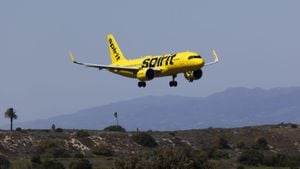SpaceX has officially embarked on what can best be described as a rescue mission for two stranded astronauts, Butch Wilmore and Suni Williams, who have been stuck aboard the International Space Station (ISS) since June. This launch marks another milestone for SpaceX, adding another chapter to its pivotal role within NASA's commercial crew program.
The mission took off from Cape Canaveral Space Force Station, Florida, at 1:17 PM, sending up onboard supplies and crew to facilitate the return of the two astronauts next February. Wilmore and Williams initially arrived on Boeing's Starliner spacecraft, which, due to unfortunate technical troubles, left them unable to return as scheduled. The Starliner capsule experienced multiple issues, leading NASA to deem it too risky to facilitate the astronauts' return.
Initially, the plan was straightforward: Wilmore and Williams were set to complete what was meant to be just eight days of work on the ISS. Instead, they have now found themselves logging over eight months of time up there, waiting for their return, all stemming from the technical chaos surrounding Boeing's spacecraft. NASA had to adjust its rescue mission accordingly, resulting in only two seats being left empty for them on the returning trip.
At the center of this theater is NASA astronaut Nick Hague and Roscosmos cosmonaut Aleksandr Gorbunov. They are visiting the ISS and will eventually return on the same spacecraft destined to bring Wilmore and Williams home. Hague previously served as commander during the launch, throwing him back to his previous experience where he had to manage crisis scenarios.
SpaceX achieved the majority of its long-standing accolades for efficiency and safety by successfully launching crewed missions since 2020, outperforming other contractors like Boeing significantly. This mission serves as another feather in SpaceX's cap, as it seeks to utilize its Dragon spacecraft—known as the "Crew Dragon"—to fulfill passenger transport responsibilities.
Hague expressed thoughts about the constant flux of human spaceflight—everything from technical hitches to personnel changes can often turn expectations upside down. He noted, "There’s always something changing; maybe this time it’s been more visible to the public," reflecting on the ever-dynamic nature of these missions. Along with Gorbunov, they will remain aboard the ISS to manage operations and deliver supplies until Wilmore and Williams are back on solid ground.
Despite the complications, this launch was instrumental for NASA. Understanding the necessity of having reliable transport systems to and from the ISS is fundamental, especially as their crew rotation process typically operates on six-month schedules. With COVID-19 and natural disasters adding layers of challenges to their operations, SpaceX's resiliency had been instrumental continually.
Among the reasons for the delays was Hurricane Helene, which postponed the launch originally planned for earlier. The waiting game for Wilmore and Williams is understandably taxing. They've been continuously training, adjusting to life aboard the ISS for much longer than anticipated, and instead of returning home, they've been immersed in scientific research and activities.
The astronauts keep themselves busy with training and, believe it or not, cooking meals—pizza night is common fare aboard the ISS. Wilmore, who has been promoted to commander of the space station, has exhibited exemplary leadership even within the constrained confines of their new limiting circumstances. The ISS community has felt the ramifications of this extended duration, but they remain dedicated to their research goals.
The path forward is clear now. With SpaceX's increasing reliance on its Falcon 9 rockets and Crew Dragon spacecraft for commercial missions, the company stands as the leader within NASA's space program. Boeing, meanwhile, is still working to troubleshoot and resolve the issues surrounding Starliner, tasked with restoring credibility and functionality to its payload transport initiatives.
With SpaceX already planning return flights for the rescued astronauts, excitement brews for what this brings for future missions as the dynamics of the international crew and the capabilities of transport systems continue to evolve. Being able to overcome hurdles—be they technical, seasonal, or logistical—plays to the strengths of human ingenuity, and as this mission showcases, the road paved by SpaceX may very well hold the keys to forging the future of space exploration.
NASA will work on simulations to prepare for more dynamic and potentially unforeseen changes as they keep pace with the demands of space travel and research, and both the crews involved and those watching from Earth await with bated breath on how this elaborate saga will conclude.



